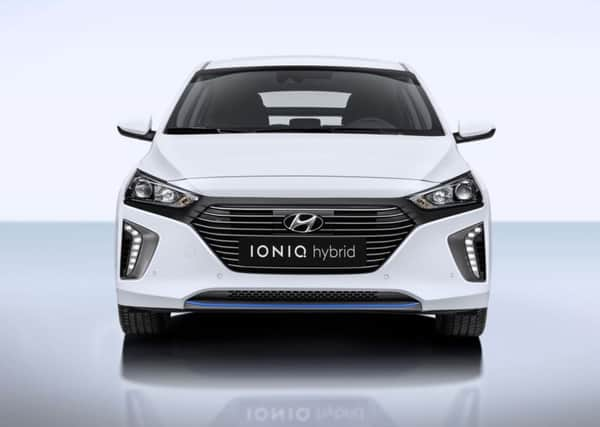Irony of Hyundai's keenly priced IONIQ electric


The body is a four-door saloon with a tailgate, and is bespoke to these power sources. The aluminium bonnet and tailgate save weight. There’s not much difference in the chassis – the main difference being multi-link rear suspension on the hybrids and a torsion beam on the electric model to allow room for the battery pack. On the outside, the electric IONIQ has no grille at the front. It looks odd.
Both have a spar across the rear window which blocks some vision.
Advertisement
Hide AdAdvertisement
Hide AdEither is easy to use – nothing to confuse the average buyer. The hybrid unit with a six-speed automatic gearbox is already in use on Kia’s new crossover, called Niro. The engine is a 1.6 petrol and combined with the motor gives 139bhp and 195lb ft.
The electric IONIQ challenges the Nissan LEAF, made in Sunderland. The hybrid’s peer is the number one hybrid, the Toyota Prius. Hyundai will happily tell you that its car undercuts the LEAF by £700 and the Prius by £3,000. That its range is greater. Prices start at £19,995 for the hybrid and £24,495 for the electric, each price benefiting from standard British government cash grants to encourage alternative fuel vehicles. The electric car emits no engine pollution on the road, meaning neither road tax nor London Congestion Charging. If you use the zone daily that’s a few thousand quid saved. The hybrids are under 100g of CO2, avoiding road tax but paying to enter the congestion zone.
If you are looking at plain miles a gallon, then a diesel gives more than the hybrid and the best petrol units run it close – and they are cheaper to buy. However, apart from the green halo which comes with hybrid ownership rather than dirtier diesel, company car drivers pay lower taxes based on the benefit of running the car.
In the electric IONIQ you can expect a range up to 173 miles on a full charge, says Hyundai. Good luck. It depends on the terrain, speeds, use of things like wipers, lights and the engine braking – which you can adjust on the go. For our designated 130-mile test route from Liverpool into Wales and back, the cars were re-boosted at the turn-round, using low emission electricity produced by wind, water, solar and other organic methods on the Rhug Estate. (Its output supplies 1,500 homes plus its farming interests.) As it happens, without the battery boost, the cars would probably have made it back to Liverpool. At the interim boost they had used 41 per cent of energy to travel 53 miles.
Hyundai’s favoured charging partner, Pod Point, had installed temporary power points – a source of interest to other motorists. As a buyer you may want to install a charging point at home or your office. They cost £300 and cables must not interfere with public rights of way, like footpaths. Ergo, you need off-street parking. Or you can rely on public charging stations – which commonly give a free charge. At home it will cost around £2.50. At a garage it will cost £6. This makes electric miles cheaper than diesel or petrol. Pod Point’s founder Erik Fairbairn predicts that electric cars will have 10 per cent of the UK new car market by 2020. Currently the share of all alternative fuel vehicle sales is just 3.3 per cent.
Petrol hybrids are now commonplace. The Kia/Hyundai method claims to give quicker response and a smoother progression than the Prius because they have different gearboxes. I am not convinced. Either is fine. I preferred the electric IONIQ to the hybrid. It was quieter, smoother, quicker and rode better on its smaller wheels. It has a price premium of £2,700.
You can kick off a debate in the pub about the ethics of all taxpayers subsidising others to buy a car of their choice, of the pollution caused by generating the mains electricity which recharges electric vehicles, and so forth. Electric and hybrid cars cost more. Without subsidies their sales would slide. As sales increase then subsidies become more of a burden. Most at risk is the subsidy for hybrids because in use they don’t match their headline mpg and CO2 figures. Hydrogen fuel to create electricity in your vehicle is now here. Hyundai’s £53,000 ix35 and Toyota’s £66,000 Mirai are now here. The mileage range and fuel costs are akin to a diesel engine but they emit no pollution.
Verdict: Hyundai’s IONIQ gives a unique choice of engines while bringing prices down.
* Hyundai Motor workers have been on strike since 24 September, although a tentative pay deal has been reached. Losses are now more than a billion dollars for the world’s No 5 car seller.